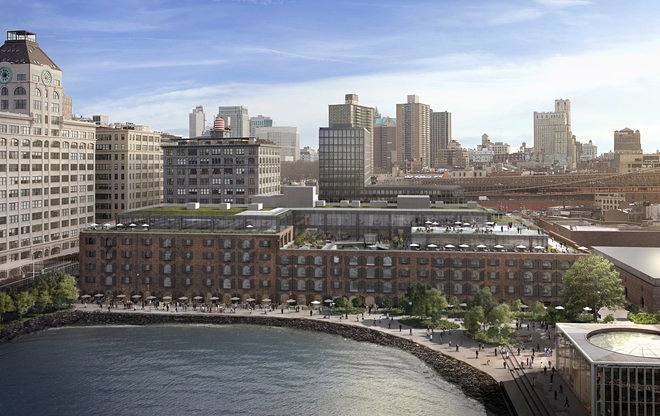Empire Stores: From Cargo Warehouse to Ruin to Development Site, 1868 to Present
The austerely impressive Empire Stores along 53-83 Water Street reveals New York City’s storied founding purpose as a port city.

Empire Stores in 1968. Photo via the Brooklyn Historical Society
The austerely impressive Empire Stores along 53-83 Water Street reveals New York City’s storied founding purpose as a port city. The complex of seven nearly 150-year-old warehouses bears “mute testimony to the prosperous commercial activity of Brooklyn during the second half of the 19th century,” in the words of the Landmarks designation report.
Today, it is a construction site, slated to open next year as a 500,000-square-foot multipurpose facility. The red-bricked, iron-shuttered walls will house various gourmet eateries as well as high-end office space, stores, a rooftop garden and exhibition space, but for most of its life, before being abandoned, Empire Stores stocked a different kind of luxury good. As a cargo warehouse, coffee beans, sugar, molasses, and the likes from Africa, South America and Cuba were the main occupants of the building.
Now part of Brooklyn Bridge Park, the site is being developed by Midtown Equities, Rockwood Capital, and HK Organization. Studio V Architecture and S9 Architecture are handling the design, which will connect the seven separate buildings via holes in the thick schist walls.
Income from a 99-year lease on the Empire Stores property will go to park maintenance. (Midtown Equities, by the way, run by father-son partners Joseph, Jack and Michael Cayre, owns and manages a portfolio of commercial properties, such as 660 Madison Avenue, where the Barneys flagship is located. It is one of three partners with a 99-year-lease to redevelop and manage the World Trade Center.)
Below, a timeline of the Empire Stores complex, leading up to its soon-to-be-continued history once the new space opens to the public in spring 2016.
1868 – “There is a most singular difficulty experienced in obtaining information as to the losses by the fire at the Empire Stores,” begins an 1868 New York Times article, regarding a general storage warehouse that burned down a year before the current Empire Stores was built on the same stretch of waterfront.
1869 – Manhattan based firm Nesmith & Sons complete construction of the Empire Stores warehouses.
1885 – Architect Thomas Stone makes additions to the site.
1901 – In the largest foreclosure sale Brooklyn has ever seen, the New York Dock Company (successor to the Brooklyn Wharf and Warehouse Company) buys two and a half miles of industrial waterfront between Red Hook’s Erie Basin and the Brooklyn Bridge — including Empire Stores.
1920 – Coffee kingpins the Arbuckle brothers acquire Empire Stores for use as a packaging, refining, and storage facility for sugar and coffee.
1956 – Following the destruction of many waterfront warehouses to make way for construction of the Brooklyn-Queens Expressway and the Brooklyn Heights Promenade, Empire Stores remains. The Port Authority of New York and New Jersey subsequently decide to retain Furman Street’s use as a cargo zone and utilize Empire Stores as part of the Brooklyn Marine Terminal.
1960s – Empire Stores is vacated and abandoned to deterioration. It will remain empty for the following half century.
1977 – Fulton Ferry becomes an historic district, with Empire Stores featuring prominently as a “monumental” 19th century complex in the designation report.
1978 – The still abandoned Empire Stores is acquired by the New York State Office of Parks, Recreation and Historic Preservation.
1994 – A New York Times article writes of multiple failed — and apparently not well publicized — attempts at revitalizing the buildings since the state acquired the complex. This despite the unanimous desire by city, developers, and locals to see Empire Stores restored.
2002 – Developer Shaya Boymelgreen is given the rights to Empire Stores by state agency the Empire State Development Corporation.
2006 – Despite an $140,000,000 promise to rehabilitate the complex four years prior, Empire Stores still sits vacant and dilapidated. The Empire State Development Corporation takes back the site, chastising Boymelgreen for letting the historic warehouses continue to deteriorate while he moved forward with other projects.
2004 – The Empire State Development Corporation issues a request for proposals to rehabilitate the Empire Stores. No developer will be selected for nearly a decade.
2010 – The Empire Stores are transferred from the state to the Brooklyn Bridge Park Corporation, which replaces the buildings’ roofs, but makes few other repairs.
September 4, 2013 – Mayor Bloomberg announces that Midtown Equities, along with Rockwood Capital and HK Organization, have been chosen to redevelop the Empire Stores complex.
2014-2015 – Restoration ideas have changed in the time since Midtown Equities was selected, but a core plan has remained to have a rooftop addition and central courtyard. Various future tenants have already leased space, including eateries Pizza East, Vinegar Hill House, Brooklyn Roasting Co., and home furnishings company West Elm.
More reading:
Empire Stores Coverage [Brownstoner]
Another Pass at Waterfront Revitalization [NY Times]
Furman Street and Warehouse Way [Brooklyn Waterfront History]
Fulton Ferry Historic District Designation Report [LPC]
Photos via the Brooklyn Historical Society, unless otherwise noted; renderings via Empire Stores

1880


Empire Stores in 1936. Photo via the New York Public Library

A photo taken in 1968


Above and below, renderings for the adaptive reuse of the landmarked complex


//
It was a massive achievement to cut through all of these schist walls. We’re thrilled to be preserving the history of Empire Stores (while letting in some necessary light).
Posted by Empire Stores on Tuesday, July 7, 2015
Overlooking Empire Stores’ rooftop terrace. pic.twitter.com/6MxZriWMKi
— Empire Stores (@empirestoresnyc) February 3, 2015





What's Your Take? Leave a Comment